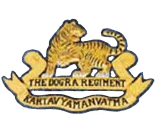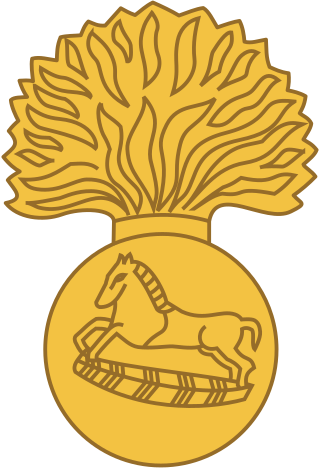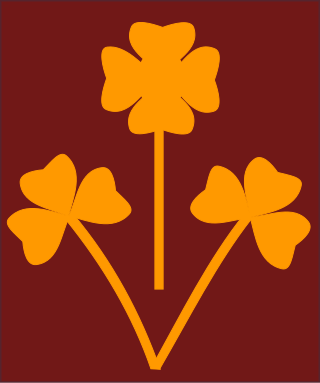
The 4th Indian Infantry Division, also known as the Red Eagle Division, is an infantry division of the Indian Army. This division of the British Indian Army was formed in Egypt in 1939 during the Second World War. During the Second World War, it took part in campaigns in East Africa, Syria, North Africa and Italy. Post independence, the division is part of the I Corps and headquartered at Prayagraj.
39th Indian Infantry Division was an infantry division of the Indian Army during World War II, which became a training division in 1943 after its recovery into India from Burma. The division was re-raised after independence and 39 Mountain Division is presently located in Palampur, Himachal Pradesh under XVI Corps.

The Dogra Regiment is an infantry regiment of the Indian Army. The regiment traces its roots directly from the 17th Dogra Regiment of the British Indian Army. When transferred to the Indian Army like its sister regiments, the numeral prefix was removed. Dogra Regiment Units Maximum filled with Rajputs And Sikh. Units of the Dogra Regiment have fought in all conflicts that independent India has been engaged in, making it one of the most prestigious and most decorated regiments of the Indian Army.

The Brigade of The Guards is a mechanised infantry regiment of the Indian Army. It was raised as the first "all India", "all class" infantry unit of the Army where troops from all parts of India serve together, as opposed to other regiments that recruit from specific regions, ethnic groups or religions.

The Parachute Regiment is an airborne and special forces regiment of the Indian Army. It was raised in 1945 as part of the British Indian Army but was disbanded after World War II and was re-raised in 1952 as part of the Indian Army. Currently it consists of fifteen Special Forces, two Territorial Army and one Rashtriya Rifles battalions.

The Grenadiers is an infantry regiment of the Indian Army, formerly part of the Bombay Army and later the pre-independence British Indian Army, when the regiment was known as the 4th Bombay Grenadiers. It has distinguished itself during the two world wars and also since the Independence of India. The regiment has won many battle honours and gallantry awards, and is considered to be one of India's most decorated regiments with three Param Vir Chakra awardees in three different conflicts.

The Punjab Regiment is the second oldest regiment still in service in the Indian Army, and is the most senior regional infantry regiment. It was formed from the 2nd Punjab Regiment of the British Indian Army in 1947 and has taken part in various battles and wars since, winning numerous honours for the same.

The Rashtriya Rifles is a counter-insurgency/counter-terrorism force in India, formed in 1990, to specifically serve in the Jammu and Kashmir region. They also maintain public order by drawing powers from the Armed Forces Special Powers Act, 1990 (AFSPA). The RR was raised by the Indian Army by reconstituting two corps. Its personnel are provided by the Indian Army on deputation. The RR is commanded by an Additional Director General of Rashtriya Rifles.

The 8th Mountain Division was raised as the 7th Indian Infantry division of the British Indian Army. It is now part of the Indian Army and specialises in mountain warfare.

The 10 RAPID Division was a war formed infantry division of the Indian Army during World War II. In four years, the division travelled over 4,000 miles (6,400 km) from Tehran to Trieste, fought three small wars, and fought two great campaigns: the Anglo-Iraqi War, the Invasion of Syria–Lebanon, the Anglo-Soviet invasion of Iran, the North African Campaign, and the Italian Campaign.

The 23rd Indian Infantry Division was an infantry division of the Indian Army during World War II. It fought in the Burma Campaign. It was then reformed as a division of the independent Indian Army in 1959.
The 11th Indian Infantry Division was an infantry division of the Indian Army during World War II. It formed part of Indian III Corps in the Malaya Command during the Battle of Malaya. The division was re-raised on 1 April 1965 and is presently part of the XII Corps of Southern Command. It is presently responsible for safeguarding the borders with Pakistan along Southern Rajasthan and Gujarat.
The 55th Indian Infantry Brigade was an infantry brigade formation of the Indian Army during World War II. It was formed in India in April 1942 and assigned to the 7th Indian Infantry Division. In July to September 1942, it was attached to the North Western Army. Afterwards the brigade was assigned to the 14th Indian Infantry Division and took part in the Burma Campaign. Apart from a short period in May 1943, the brigade remained with the 14th Division until the end of the war and was 14th Division was allocated as a training division, the brigade was reorganised as a training brigade in June 1943.
The Nowshera Brigade was an infantry brigade formation of the Indian Army during World War II. It was formed in September 1939, for service on the North West Frontier. It was normal practice for newly formed battalions to be posted to the North West Frontier for service before being sent to Africa, Burma or Italy.
The Peshawar Brigade was an infantry brigade formation of the Indian Army during World War II. It was formed in December 1907, for service on the North West Frontier. During World War II it was normal practice for newly formed battalions to be posted to the North West Frontier for service before being sent to Africa, Burma or Italy.
Second Battle of Monte Cassino order of battle February 1944 is a listing of the significant formations involved in the fighting on the Winter Line in February 1944 during the period generally known as the Second Battle of Monte Cassino.
The Order of battle, Keren 1941 shows Italian army forces that participated in the Battle of Keren from February to March 1941 and British troops in Sudan on 20 January 1941, which participated in military operations against Eritrea during the East African Campaign 1940–1941.
Officers and soldiers of the Indian Army wear cap badges on their beret or peaked caps. The design is based on the regimental insignia or coat of arms.

The 54th Infantry Division is an Infantry division of the Indian Army. The Division was raised as an Infantry Division, but was converted into a Reorganised Amphibious Formation (RAMFOR) in 2011. It is currently the only division of the Indian Army which carries out Amphibious warfare. The division is headquartered at Secunderabad in Telangana and is a part of XXI Corps. The Division is commanded by an Officer of the rank of Major General titled General Officer Commanding (GOC).











